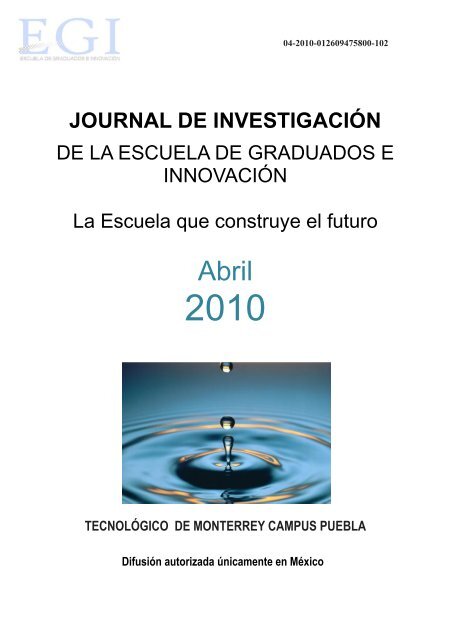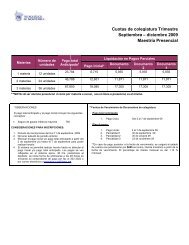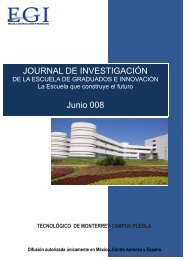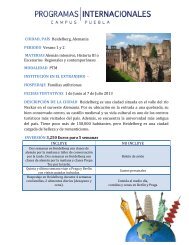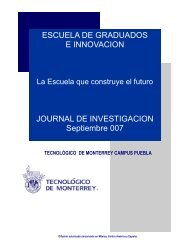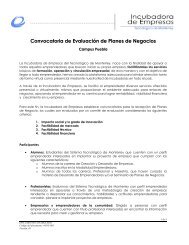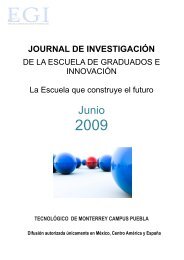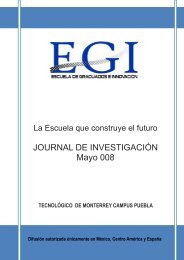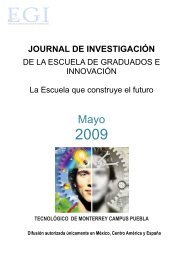journal de investigación - Campus Puebla - Tecnológico de Monterrey
journal de investigación - Campus Puebla - Tecnológico de Monterrey
journal de investigación - Campus Puebla - Tecnológico de Monterrey
Create successful ePaper yourself
Turn your PDF publications into a flip-book with our unique Google optimized e-Paper software.
04-2010-012609475800-102<br />
JOURNAL DE INVESTIGACIÓN<br />
DE LA ESCUELA DE GRADUADOS E<br />
INNOVACIÓN<br />
La Escuela que construye el futuro<br />
Abril<br />
2010<br />
TECNOLÓGICO DE MONTERREY CAMPUS PUEBLA<br />
Difusión autorizada únicamente en México
Journal <strong>de</strong> Investigación <strong>de</strong> la Escuela <strong>de</strong> Graduados e Innovación<br />
Tec <strong>de</strong> <strong>Monterrey</strong> <strong>Campus</strong> <strong>Puebla</strong> [Abril‘10]<br />
<strong>Puebla</strong>, Pue. Abril „10<br />
Estimados alumnos, profesores, investigadores invitados y compañeros <strong>de</strong> la Escuela <strong>de</strong> Graduados e<br />
Innovación “EGI”, <strong>de</strong>l Tec <strong>de</strong> <strong>Monterrey</strong> <strong>Campus</strong> <strong>Puebla</strong>:<br />
Este mes lanzamos el vigésimo cuarto volumen <strong>de</strong>l “Journal <strong>de</strong> Investigación <strong>de</strong> la “EGI”, el cual mantiene<br />
la intención inicial con que partimos <strong>de</strong> difundir nuestras experiencias técnicas, académicas, <strong>de</strong><br />
<strong>investigación</strong> y casos <strong>de</strong> éxito.<br />
Es nuestro <strong>de</strong>seo que en cada trimestre contemos con más colaboradores, para que <strong>de</strong> esa manera, este<br />
esfuerzo se mantenga como un foro <strong>de</strong>stinado a influir positivamente en los ámbitos económico, político y<br />
social <strong>de</strong> nuestra comunidad.<br />
Atte.<br />
Dr. Jaime Raúl Alejandro Romero Jiménez<br />
Director <strong>de</strong> la Escuela <strong>de</strong> Graduados e Innovación<br />
ITESM <strong>Campus</strong> <strong>Puebla</strong><br />
alejandro.romero@itesm.mx
Journal <strong>de</strong> Investigación <strong>de</strong> la Escuela <strong>de</strong> Graduados e Innovación<br />
Tec <strong>de</strong> <strong>Monterrey</strong> <strong>Campus</strong> <strong>Puebla</strong> [Abril‘10]<br />
Nuestra revista es una publicación sin fines <strong>de</strong> lucro; el único y exclusivo titular <strong>de</strong>l <strong>de</strong>recho moral <strong>de</strong> los<br />
artículos son los autores.<br />
Prohibida la reproducción parcial o total <strong>de</strong> estas obras, por cualquier medio o método, sin autorización<br />
por escrito <strong>de</strong>l Autor. El único responsable <strong>de</strong> cada publicación es el autor; y por en<strong>de</strong>, se <strong>de</strong>slinda <strong>de</strong><br />
toda responsabilidad al Instituto <strong>Tecnológico</strong> y <strong>de</strong> Estudios Superiores <strong>de</strong> <strong>Monterrey</strong>, <strong>Campus</strong> <strong>Puebla</strong>.<br />
Los autores pue<strong>de</strong>n tener relaciones <strong>de</strong> consultoría u otros negocios con las empresas a que se refieran.<br />
Si <strong>de</strong>seas que el Journal publique algún artículo <strong>de</strong> tu autoría, por favor escríbenos a:<br />
comiteditorial.pue@servicios.itesm.mx<br />
Comité Editorial<br />
Dr. Alejandro Romero<br />
Dr. Clau<strong>de</strong> Chalain<br />
Lic. Gabriela Kauffmann<br />
Dr. Juan Carlos Gachúz<br />
Dr. Jaime Contreras<br />
Mtro. Alfredo García
Journal <strong>de</strong> Investigación <strong>de</strong> la Escuela <strong>de</strong> Graduados e Innovación<br />
Tec <strong>de</strong> <strong>Monterrey</strong> <strong>Campus</strong> <strong>Puebla</strong> [Abril‘10]<br />
INVITACIÓN<br />
Se invita a la comunidad <strong>de</strong>l ITESM <strong>Campus</strong> <strong>Puebla</strong> (estudiantes y profesores) a enviar sus propuestas<br />
<strong>de</strong> publicación para el Journal <strong>de</strong> Investigación <strong>de</strong> la Escuela <strong>de</strong> Graduados e Innovación. Esta<br />
publicación sin fines <strong>de</strong> lucro procura la divulgación sobre diversas líneas <strong>de</strong> <strong>investigación</strong>, incluyendo las<br />
que se han trazado como prioritarias para el <strong>Tecnológico</strong> <strong>de</strong> <strong>Monterrey</strong>.<br />
Éstas áreas son las <strong>de</strong> Biotecnología (genómica, biofármacos, nutracéuticos); Medicina (células madre,<br />
ingeniería biomédica); Nanotecnología (materiales nano-estructurados, nano-electrónica, rayos láser<br />
adifraccionales); TIC‟s (dispositivos móviles, buscadores inteligentes, seguridad informática); Mecatrónica<br />
(diseño <strong>de</strong> productos y máquinas para la industria automotriz y aeronáutica); Medio Ambiente (energía<br />
eólica, calidad <strong>de</strong>l aire y <strong>de</strong>l agua, viviendas <strong>de</strong> bajo costo); Administración Pública (<strong>de</strong>sarrollo regional,<br />
competitividad internacional, relaciones internacionales); Administración <strong>de</strong> Empresas (mo<strong>de</strong>los <strong>de</strong><br />
negocio, empresas familiares, ética, propiedad intelectual); y Educación (didáctica, uso <strong>de</strong> la tecnología,<br />
administración educativa).<br />
La fecha límite <strong>de</strong> recepción <strong>de</strong> documentos es el día 28 abril <strong>de</strong> manera que puedan ser<br />
consi<strong>de</strong>rados para publicación en la próxima edición. Les recordamos que los requisitos en formato son:<br />
formato Word, con letra Arial Narrow 11 a espacio sencillo, título en Helvética 12; si el trabajo requiere <strong>de</strong>l<br />
uso <strong>de</strong> citas bibliográficas estas <strong>de</strong>berán usar el sistema MLA utilizando letra Helvética <strong>de</strong> 8 puntos. Las<br />
contribuciones podrán ser redactadas en inglés o español.<br />
El Comité Editorial evaluará las propuestas <strong>de</strong> publicación <strong>de</strong> los artículos; estamos a sus ór<strong>de</strong>nes en el<br />
correo: comiteditorial.pue@servicios.itesm.mx<br />
Saludos cordiales,<br />
Comité Editorial.
Journal <strong>de</strong> Investigación <strong>de</strong> la Escuela <strong>de</strong> Graduados e Innovación<br />
Tec <strong>de</strong> <strong>Monterrey</strong> <strong>Campus</strong> <strong>Puebla</strong> [Abril‘10]<br />
Contenido<br />
INVITACIÓN……………………………………………………………………………………<br />
………... ..................................................................................................................................................4<br />
CONTENIDO……………………………………………………………………………………<br />
………... ..................................................................................................................................................5<br />
SANTO EL SEPULCRO, MALDITO EL ORIGEN ..........................................................................6<br />
MARCOS NUCAMENDI, ALUMNO DEL ITESM CAMPUS PUEBLA<br />
CONTINUOUS IMPROVEMENT SURVEY IN MEXICO ………….. .......................... ……..…14<br />
LUIS A. J. BORGES, * DR. JAIME CONTRERAS DÍAZ, *PROFESOR DEL ITESM<br />
CAMPUS PUEBLA<br />
MULTINATIONAL ENTERPRISES AND DEVELOPMENT…..............................................20<br />
DR. JUAN CARLOS GACHUZ MAYA ,DIRECTOR DE POSGRADOS<br />
DIRECTORIO ……………………………………………………...……………………………...……23
Journal <strong>de</strong> Investigación <strong>de</strong> la Escuela <strong>de</strong> Graduados e Innovación<br />
Tec <strong>de</strong> <strong>Monterrey</strong> <strong>Campus</strong> <strong>Puebla</strong> [Abril‘10]<br />
Santo el sepulcro, maldito el origen.<br />
Por Marcos Nucamendi<br />
“Vos, mi linda niña.<br />
¿Cómo te llamás?<br />
Yo me llamo CHIA<br />
y me apellido PAZ…”<br />
Óscar Chávez<br />
“Chiapas, un día lejano,<br />
y serena, tranquila y transparente,<br />
<strong>de</strong>bió brotar <strong>de</strong>l mar ebrio <strong>de</strong> espuma,<br />
o <strong>de</strong>l vientre cósmico <strong>de</strong> una aurora”<br />
Enoch C. Casahonda<br />
SUMARIO: I. Introducción. II. Los organismos. III. Los campesinos.<br />
IV. ¿Qué hacer? V. Conclusión.<br />
I. Introducción.<br />
Reservada a la voluntad <strong>de</strong>l po<strong>de</strong>roso, la sepultura nace como muchas otras biosferas <strong>de</strong> papel, <strong>de</strong>l<br />
<strong>de</strong>signio y para el beneficio <strong>de</strong> las estadísticas, más, que por la necesaria protección <strong>de</strong> la vida.<br />
“Protegiendo” la vida, se intenta <strong>de</strong>shojar a sus más recientes pobladores, que cosechando <strong>de</strong>stino y<br />
bienmorir, en medio <strong>de</strong>l sepulcro, dieron nombre a “Los Angeles” (ejido en medio <strong>de</strong> la Reserva <strong>de</strong> la<br />
Biósfera, La Sepultura, Chiapas). El siguiente ensayo, correspon<strong>de</strong> a la observancia, durante seis días,<br />
<strong>de</strong> testigos fieles <strong>de</strong> una situación que se repite en tantas otras partes: allá don<strong>de</strong> un gusano<br />
<strong>de</strong>scompone materia orgánica y un ejido se organiza para no <strong>de</strong>scomponerse. Allá don<strong>de</strong> gobierno y<br />
circunstancias, colu<strong>de</strong>n fuerzas, para no hacer fácil la vida <strong>de</strong>l campesino, haciendo irrisoriamente<br />
confortable, la vida propia. Ésta es la historia <strong>de</strong>l Chiapas <strong>de</strong>sconocido, ignorado y a veces, guardado en<br />
los anaqueles <strong>de</strong>l olvido.<br />
El ensayo, irá acompañado <strong>de</strong> distintos poemas <strong>de</strong> mi propia autoría, con la pobreza <strong>de</strong> mi<br />
inventiva, pero con la humildad que <strong>de</strong>seoso, quisiese transmitir a quien los lea.<br />
I. Los organismos<br />
Ciegos intrusos<br />
Intrusos que se a<strong>de</strong>ntran al paraíso, <strong>de</strong>scuidados,<br />
parecen ser vigilados por divinida<strong>de</strong>s que no se erigen en mármol,<br />
que no viven en espacios celestes inalcanzables,<br />
y que dudosos, permiten la entrada a escépticos y <strong>de</strong>spreocupados.<br />
Alertas se muestran con cada crujir <strong>de</strong> la hojarasca,<br />
con cada crujir <strong>de</strong> rama seca,
Journal <strong>de</strong> Investigación <strong>de</strong> la Escuela <strong>de</strong> Graduados e Innovación<br />
Tec <strong>de</strong> <strong>Monterrey</strong> <strong>Campus</strong> <strong>Puebla</strong> [Abril‘10]<br />
que el tiempo y los gusanos <strong>de</strong>scomponen.<br />
Alertas se <strong>de</strong>snudan,<br />
a los ciegos presurosos.<br />
Sólo unos cuantos se <strong>de</strong>tienen,<br />
justo, cuando su danza comienza.<br />
Maravillados los ciegos, abren los ojos <strong>de</strong> apoco,<br />
maravillados los ciegos, intentan clavar su mirada,<br />
maravillados los ciegos, tratan <strong>de</strong> enten<strong>de</strong>r lo antes ininteligible,<br />
maravillados los ciegos, <strong>de</strong>jan <strong>de</strong> ser ciegos,<br />
para convertirse en chinche, escarabajo y mariposa.<br />
Tal cual intrusos y ciegos, nos recibieron en el centro <strong>de</strong> su hábitat, las “divinida<strong>de</strong>s” siempre<br />
vigilantes; respetar actitud como ésta, <strong>de</strong>pen<strong>de</strong> únicamente, <strong>de</strong>l pensamiento <strong>de</strong> cada quien, <strong>de</strong> cada<br />
cual. Para muchos, la caminata es larga y cansada, para otros, corta y apreciada. Los organismos que<br />
<strong>de</strong>s<strong>de</strong> siglos viven celosos <strong>de</strong> su morada, dan cátedra <strong>de</strong> comportamiento a los ciegos ignominiosos y<br />
<strong>de</strong>structores, haciendo lo que cada día, tiempo y existencia, les han enseñado.<br />
El ser humano <strong>de</strong>cía Marx, es bueno por naturaleza, son las circunstancias y la ambición<br />
conjunta, lo que distorsiona su en<strong>de</strong>ble consciencia. Nosotros, nacemos buenos, pero la sed <strong>de</strong> po<strong>de</strong>r y<br />
progreso, <strong>de</strong>forma nuestro papel en el mundo cíclico interminable que acaece sobre la tierra. ¿Cuál es<br />
entonces nuestra justificación? Para arrasar con vidas ajenas, para cortar a machete y saña, el enramado<br />
<strong>de</strong> la vida en el cielo, en tres picos, o en el resto <strong>de</strong> la Sepultura.<br />
En diez años, la vida en la reserva ha cambiado significativamente, la proporción <strong>de</strong> suelos,<br />
vegetación y fauna, afirma una situación culposa. Los primeros dueños, siguen existiendo, porque aún<br />
pue<strong>de</strong>n, porque la mano <strong>de</strong>l hombre –“indulgente”-, se inmoviliza por estaciones, pero calcinando<br />
nuevamente la vida cuando retoma su afán diario. Cada vez que se <strong>de</strong>spoja <strong>de</strong> hogar a quienes<br />
pacíficamente recorren el universo ver<strong>de</strong>; a quienes esperando protección <strong>de</strong> un ejército, la reciben <strong>de</strong><br />
dos gentes; a quienes esperando <strong>investigación</strong> y acción <strong>de</strong> profesionales, reciben un cita sobre la página<br />
<strong>de</strong> un libro que reposa en las estanterías; a quienes esperando la organización <strong>de</strong> “Los Ángeles”, ven con<br />
penuria el poco, pero consolador esfuerzo:<br />
Facilidad acallada<br />
Qué tan fácil sería, si tan sólo,<br />
los humanos nos comportásemos como la naturaleza siempre hace,<br />
creando relaciones que repartan beneficios y compartan responsabilida<strong>de</strong>s,<br />
por qué siempre los que ganan son tan pocos, y los que pier<strong>de</strong>n tan muchos,<br />
por qué Lucía, una inadvertida mariposa, habrá <strong>de</strong> ver con lágrimas en los ojos,<br />
cómo su hogar es <strong>de</strong>rrumbado por monstruos que toman fotografías,<br />
y que callados, <strong>de</strong>jan a su suerte,<br />
a los últimos vestigios <strong>de</strong> vida silvestre.<br />
Qué fácil en verdad sería… ¿qué brecha tan insalvable, existe entre la naturaleza y nosotros los<br />
humanos, entre las relaciones interesadas y las relaciones doblemente benéficas? Así como el ixcanal<br />
ce<strong>de</strong> casa a pequeñas hormigas -que la tradición menciona, saben a fresa-, así las hormigas <strong>de</strong>fien<strong>de</strong>n al<br />
árbol en cuyas espinas se guarecen. Por algo la etimología lo llama “lugar sagrado en que penetra la<br />
energía <strong>de</strong>ntro <strong>de</strong> la tierra”, por algo resulta ser, una perfecta simbiosis entra la colonia y los colonos.<br />
Como otros colonos, que en su búsqueda <strong>de</strong> celulosa, construyen largos túneles que no<br />
atraviesan cerros, sino gran<strong>de</strong>s enramados <strong>de</strong> un viejo árbol. Son las termitas, quienes intentan recorrer
Journal <strong>de</strong> Investigación <strong>de</strong> la Escuela <strong>de</strong> Graduados e Innovación<br />
Tec <strong>de</strong> <strong>Monterrey</strong> <strong>Campus</strong> <strong>Puebla</strong> [Abril‘10]<br />
un ancho tronco, creyendo que el mundo se reduce a su estadio en ese lugar; mientras nadie las<br />
<strong>de</strong>scubra y sigan teniendo comida suficiente, no habrá termita <strong>de</strong>sdichada.<br />
Qué <strong>de</strong>cir <strong>de</strong> ti, preciosa monarca, que sustrayendo la miel <strong>de</strong> una sortija, envenenas al ave que<br />
<strong>de</strong>sea acabar con tu reino. Son sortijas que no se crean en joyerías receptoras <strong>de</strong> explotación en gramos<br />
<strong>de</strong> piedras preciosas, sino que crecen <strong>de</strong>s<strong>de</strong> la tierra; es una monarca que no <strong>de</strong>creta a su antojo<br />
injusticias, sino que recibe el nombre por el fastuoso patrón ámbar y negro <strong>de</strong> su alas; es un reino, que no<br />
<strong>de</strong>sperdiga, presume y oprime, sino uno que recorre naturalmente, la senda anual migratoria.<br />
Aún cuando reino y colonias <strong>de</strong>saparezcan, aún cuando los troncos y el <strong>de</strong>sperdicio, caigan<br />
sobre la vastedad <strong>de</strong>l ecosistema, hay flores que nacen <strong>de</strong> su último aliento, hay flores que no se ven<strong>de</strong>n<br />
en elegantes establecimientos, ni ruborizan a la mujer amada. Tienen formas varias, se comen,<br />
envenenan, incluso alucinan. Son los hongos que nacen <strong>de</strong>l <strong>de</strong>secho, para completar el ciclo que la<br />
propia naturaleza comienza haciendo crecer la hierba. ¿Por qué no imitarlos entonces? Por qué no,<br />
completar los ciclos, que hemos comenzado:<br />
Ciudadano precoz<br />
Tú hombre, tú mujer,<br />
que tus primeros pasos fueron recibidos por el frío concreto,<br />
extrañado te has <strong>de</strong> sentir en tierra virgen,<br />
que se escon<strong>de</strong> se ti, tras los límites <strong>de</strong> la explotación.<br />
Tú hombre, tú mujer,<br />
que tu niñez las has vivido subiendo escaleras y elevadores,<br />
extrañado te has <strong>de</strong> sentir al subir y bajar por montañas, troncos y suaves veredas.<br />
Tú hombre, tú mujer,<br />
que la circunstancia y el tiempo te hicieron ser ciudadano precoz,<br />
compasión exhalas con cada suspiro, con cada pregunta y con cada pensamiento,<br />
que renovados, han aceptado la invitación <strong>de</strong> tu madre verda<strong>de</strong>ra, tu madre tierra,<br />
que <strong>de</strong>s<strong>de</strong> hace años, está <strong>de</strong>seosa <strong>de</strong> recibirte,<br />
para hacer a un lado, la nostalgia <strong>de</strong> tu insoportable extravío.<br />
Es la coyuntura <strong>de</strong>l nacimiento, quien hace <strong>de</strong> los hijos, extraños en su propia casa. Los que<br />
venimos <strong>de</strong> ciudad, cautos damos la primer pisada, atentos a cualquier sonido que exponga peligro<br />
estamos, intranquilos con la humedad <strong>de</strong> las hojas que intentan <strong>de</strong>jarnos huella <strong>de</strong> <strong>de</strong>sprecio nos<br />
encontramos, presos <strong>de</strong> nuestra propio pensamiento infundado vamos caminando.<br />
¿Qué tan difícil es a<strong>de</strong>ntrarse abierto al microcosmos <strong>de</strong> la montaña? ¿Qué tan difícil es disfrutar<br />
<strong>de</strong>l paraíso? ¿Qué tan difícil es <strong>de</strong>jar atrás, o en espera momentánea, los mal llamados placeres <strong>de</strong> la<br />
vida urbana? ¿Qué tan difícil es volverse chinche, escarabajo o mariposa?, reposar sobre una hoja, lamer<br />
el polen <strong>de</strong> una flor, o simplemente mecerse con el viento que anticipa torrencial:<br />
Tres picos<br />
Tres picos se alzan en el horizonte nublado,<br />
once árboles marcan la senda <strong>de</strong>l hombre, <strong>de</strong> la mujer,<br />
quince gentes van subiendo omisos,<br />
mientras veinte cienpiés tratan <strong>de</strong> evitar ser abatidos.<br />
Tres picos siguen alzándose en el horizonte nublado,<br />
cinco árboles más, marcan la senda <strong>de</strong>l hombre, <strong>de</strong> la mujer,<br />
quince gentes van bajando cuidadosos,
Journal <strong>de</strong> Investigación <strong>de</strong> la Escuela <strong>de</strong> Graduados e Innovación<br />
Tec <strong>de</strong> <strong>Monterrey</strong> <strong>Campus</strong> <strong>Puebla</strong> [Abril‘10]<br />
mientras un pavón trata <strong>de</strong> premiar con su canto,<br />
a más <strong>de</strong> un piadoso.<br />
Si esto suce<strong>de</strong> tras el choque <strong>de</strong> los humanos con la naturaleza, ¿qué pasara cuando chocamos,<br />
humanos con humanos?:<br />
Es claro el enfrentamiento, entre el hombre/la mujer <strong>de</strong> concreto y el hombre/la mujer que <strong>de</strong> la<br />
tierra nace y en ella se queda a cosechar el tiempo. El hombre/la mujer <strong>de</strong> ciudad absorbe vorazmente<br />
los frutos que <strong>de</strong> ella brotan, no ve más allá <strong>de</strong>l plato que tiene frente <strong>de</strong> si, da el último bocado sin saber<br />
quién habrá puesto pies y manos para alimentar panza ajena, ni quién se <strong>de</strong>svive o se <strong>de</strong>smuere, para<br />
conservar la poca savia que le queda al mundo.<br />
Por fortuna, los quince hombres/mujeres, que subieron a tres picos, bajan con un nuevo<br />
pensamiento. Es la calma y compromiso <strong>de</strong> nuestros guías <strong>de</strong> camino, lo que <strong>de</strong>smitifica la inacción <strong>de</strong><br />
estos. Nos encontramos con hombres que aunque parezca inútil su esfuerzo, están ahí, haciendo lo que<br />
pue<strong>de</strong>n, y pudiendo hacer lo que otros no quieren.<br />
II. Los campesinos.<br />
“[…] Descubre campos sembrados,<br />
por la esperanza <strong>de</strong> mis hermanos,<br />
que <strong>de</strong>jaron pies y manos,<br />
para alimentar al sol”<br />
César Gandy<br />
Pero no es hasta los últimos dos días en la Sepultura, en que los ojos <strong>de</strong> los ciegos, se abren por<br />
completo, quizá algunos vean sombras, pero estoy seguro que la mayoría ve ahora, claramente. Los<br />
corazones <strong>de</strong> las montañas y las parcelas <strong>de</strong> los ejidatarios, fueron el epicentro <strong>de</strong>l cambio, <strong>de</strong> opiniones<br />
falsamente cortejadas por la memoria y <strong>de</strong> opiniones ilusoriamente adoctrinadas como verda<strong>de</strong>ras,<br />
absolutas e inmutables:<br />
Corazón 1<br />
Entre alar<strong>de</strong>s <strong>de</strong> guerrillero,<br />
parados en el corazón <strong>de</strong> <strong>de</strong> la montaña,<br />
se escucha agitación y se seca la garganta,<br />
un día cualquiera sería,<br />
para aquellos que se les niega el día,<br />
un día cualquiera sería,<br />
para aquellos que viven,<br />
en el calendario <strong>de</strong> la rebeldía.<br />
Corazón 2<br />
Poca confianza y riña,<br />
la circulación cortaron,<br />
el corazón palpita,<br />
<strong>de</strong>shaciéndose,<br />
mañana serena,<br />
la circulación curó,<br />
el corazón palpita,<br />
reconstruyéndose.
Journal <strong>de</strong> Investigación <strong>de</strong> la Escuela <strong>de</strong> Graduados e Innovación<br />
Tec <strong>de</strong> <strong>Monterrey</strong> <strong>Campus</strong> <strong>Puebla</strong> [Abril‘10]<br />
Los corazones, representaron todo una prueba, no sólo <strong>de</strong> resistencia, sino <strong>de</strong> compromiso y<br />
disposición propios. ¿Qué tan real era el trabajo <strong>de</strong> campo?, ¿con cuánta seriedad se tomó el pedir<br />
prestado un pedazo <strong>de</strong> piel <strong>de</strong> la tierra?, ¿qué prevaleció en esas horas, la unión o la <strong>de</strong>sesperación<br />
combinada con <strong>de</strong>sconfianza?<br />
Son alar<strong>de</strong>s, las palabras que dicta la resistencia leída. Son alar<strong>de</strong>s, las riñas internas por<br />
problemas imprevistos. Son reales, las manos que cavan una zanja en el cauce y la<strong>de</strong>ra <strong>de</strong> la montaña,<br />
que arrancan la vida que no pertenece a los quince centímetros que se han profundizado, que sienten su<br />
textura y guardan muestras, en moradas <strong>de</strong> plástico.<br />
Hasta que surgen problemáticas, es que nos ponemos serios. El primer corazón fue cansado, no<br />
sólo por el constante movimiento entre la vegetación que nos cerraba el paso, sino también por el<br />
agotamiento <strong>de</strong> las discusiones En el punto ocho, pareciese aún eterno el muestreo, confundiéndose con<br />
holgazanería nuestra, el enredo causado.<br />
El corazón dos, <strong>de</strong>bido a que se trató <strong>de</strong> un paraje más <strong>de</strong>spejado y brotara un acahual<br />
dominante, fue un regalo para la mínima frustración, mejor organización y rápida extracción <strong>de</strong> las<br />
muestras <strong>de</strong> suelo. Con las mochilas llenas <strong>de</strong> arcilla, limo y arena, regresamos al campamento, para<br />
prepararnos, presentarnos con la gente y dirigirnos a facilitar el trabajo comunitario, con ampollas y sin<br />
queja alguna. Únicamente atentos, escuchando instrucciones simples, aprovechando el <strong>de</strong>scanso, para<br />
conversar con nuestros hermanos <strong>de</strong>purados <strong>de</strong> la remembranza colectiva.<br />
Son los campesinos, quienes dan la mejor cátedra <strong>de</strong> comunidad. Son los campesinos, quienes<br />
amablemente nos permiten acompañarlos en la interminable labranza <strong>de</strong> la vida misma. Preocupados,<br />
como no lo están quienes pusieron nombre a la biosfera, han <strong>de</strong>cidido empren<strong>de</strong>r un proyecto <strong>de</strong><br />
reforestación, conscientes <strong>de</strong>l daño que suce<strong>de</strong> tras el crecimiento poblacional y extensión <strong>de</strong> las tierras<br />
<strong>de</strong> cultivo y pastoreo.<br />
El primer día, Marisol, Blanca y quien escribe, nos dirigimos al terreno <strong>de</strong> Don Ángel, a quien en<br />
agra<strong>de</strong>cimiento, le <strong>de</strong>dico el siguiente poema:<br />
Don Ángel<br />
A usted Don Ángel,<br />
que pa’ seguirle el ritmo,<br />
se necesita no sólo disposición,<br />
sino unas cuantas ampollas,<br />
y reflexión <strong>de</strong>s<strong>de</strong> el corazón.<br />
A usted Don Ángel,<br />
hijo <strong>de</strong> fundadores.<br />
A usted Don Ángel,<br />
que trabaja <strong>de</strong> la tierra,<br />
media jornada <strong>de</strong> sudor nuestro,<br />
no se compara con tantos años que con tal <strong>de</strong> vivirlos,<br />
a pasar pena y gloria, ha estado dispuesto.<br />
A usted Don Ángel,<br />
que ha compartido el viaje y regreso <strong>de</strong> sus hermanos migrantes,<br />
gratitud la vida le ha brindado,<br />
viendo que su familia no está distante.
Journal <strong>de</strong> Investigación <strong>de</strong> la Escuela <strong>de</strong> Graduados e Innovación<br />
Tec <strong>de</strong> <strong>Monterrey</strong> <strong>Campus</strong> <strong>Puebla</strong> [Abril‘10]<br />
A usted Don Ángel,<br />
que ve en nuestras pequeñas zanjas, símbolos <strong>de</strong> sinceridad,<br />
hemos <strong>de</strong> agra<strong>de</strong>cerle más que un vaso <strong>de</strong> agua,<br />
está oportunidad,<br />
<strong>de</strong> conocerlo, <strong>de</strong> conocernos.<br />
Don Ángel es para mí, que nací en tierra maya-zoque-chipaneca, uno <strong>de</strong> mis hermanos más<br />
cercanos, escondido <strong>de</strong> mi lastimera vista, por la distancia contada en kilómetros, y por la distancia,<br />
contada en los días apacibles <strong>de</strong> mi vida diaria, que no se daba la oportunidad <strong>de</strong> traspasar la barrera<br />
invisible <strong>de</strong>l centralismo capitalino <strong>de</strong> la entidad.<br />
Su inacabable paciencia, al cuidado <strong>de</strong> sus ayudantes torpes por el apremio, es imprescindible<br />
para conocer más <strong>de</strong> cerca, a tan entrañable persona. Aunque en un principio se mostraba -y nos<br />
mostrábamos un tanto callados-, los minutos disminuyeron la brecha a la que los tres metros <strong>de</strong><br />
separación entre pozo y pozo nos obligaban.<br />
Empezando la tarea, la pala pareciese suave, como si sola, se enterrase en la tierra, queriendo<br />
hacernos más sencilla la tarea asignada. Pasa una hora y los cerros aparecen en las palmas <strong>de</strong> nuestras<br />
manos, cada vez que levantamos la herramienta. En las palmas <strong>de</strong> todos, menos en la que que durante<br />
años, “alimentan al sol”.<br />
En el intermedio, Don Ángel se acerca con una “Big cola”, un gran alivio para nuestras<br />
gargantas, y aunque lo oculte, también para la suya. Primero nos ofrece a nosotros, <strong>de</strong>spués, bebe<br />
tranquilamente <strong>de</strong> su vaso amarillo, gastado por el uso. Pasados diez minutos, seguimos cavando,<br />
seguimos haciendo nido, a los árboles que vendrán, al wash y mataratón, que esperan encontrar cálido<br />
su refugio perpetuo.<br />
Terminado el interludio, Don Ángel se <strong>de</strong>sconcentra por las preguntas <strong>de</strong> un impaciente, a las<br />
que respon<strong>de</strong>, amigablemente. Sin mostrarse huraño, sólo complacido por el interés <strong>de</strong> “echar la plática”,<br />
me cuenta <strong>de</strong> cómo han sido sus primeros pasos –siendo hijo <strong>de</strong> uno <strong>de</strong> los fundadores-, <strong>de</strong> cómo sus<br />
hermanos <strong>de</strong>cidieron viajar a Colorado porque colorados ya estaban <strong>de</strong> tanto sol sin moneda a cambio, y<br />
<strong>de</strong> cómo él se quedó, velando por el crecimiento <strong>de</strong>l ejido. En cambio, hay a quienes la realidad, los ha<br />
tomado <strong>de</strong>sprevenidos.<br />
El segundo día, se formaron nuevos equipos: Fernanda, Cristina, Robin, Montserrat, Paulina,<br />
Eduardo y quien sigue escribiendo, nos enlistamos en el equipo <strong>de</strong> Jorge, al que luego se uniría su<br />
“compa” Joel. Atravesando el río sobre el lomo <strong>de</strong> una mula un tanto arisca, llegamos a la hectárea que<br />
espera ansiosa, el regreso <strong>de</strong> sus dueños, y el nacimiento <strong>de</strong> sus retoños. A ellos, Joel y Jorge, con quien<br />
compartí palabra y agua, les <strong>de</strong>dico los siguientes versos:<br />
Joel y Jorge.<br />
Joel y Jorge,<br />
migrantes mexicanos,<br />
migrantes chiapanecos,<br />
que hacía unos años atravesaron la frontera,<br />
buscaban lo que en su tierra, no se cosecha.<br />
Fueron impulsados por la necesidad y la sed <strong>de</strong> probar,<br />
el agua bendita y la miel que les prometieron los murmullos,<br />
<strong>de</strong> aquellos que regresaron, extrañando cuna y capullo.<br />
Rápido y afortunado fue el asenso,<br />
la suerte parecía congraciarlos,
Journal <strong>de</strong> Investigación <strong>de</strong> la Escuela <strong>de</strong> Graduados e Innovación<br />
Tec <strong>de</strong> <strong>Monterrey</strong> <strong>Campus</strong> <strong>Puebla</strong> [Abril‘10]<br />
mas la duda, el dispendio y el olvido,<br />
logró sujetarlos.<br />
Aturdidos por un sueño engañoso,<br />
emprendieron un regreso más doloroso,<br />
llegaron a quedarse y compartir recuerdos,<br />
labrando la tierra, trabajando juntos,<br />
como fue antes, como fue siempre.<br />
Pensando cada uno <strong>de</strong> ellos,<br />
postran su mirada en lo alto cerro,<br />
uno, tiene ahora hija y mujer por las cuales ocuparse,<br />
otro, aunque parece saberse <strong>de</strong>l peligro <strong>de</strong> las pesadillas,<br />
siente, y siente su tierra, la nostalgia,<br />
por tierras ajenas.<br />
Cierto que <strong>de</strong>sprevenidos los ha tomado la realidad, cierto que sencilla fue -en comparación con<br />
otros-, la travesía por la ruta migrante. Dicen que a cada persona que principia el viaje, le son violados<br />
por lo menos una vez, sus <strong>de</strong>rechos humanos; con sus contadas excepcionalida<strong>de</strong>s. Si bien, arribaron a<br />
los Estados Unidos sin ser perseguidos, atrapados por balas <strong>de</strong> los amigos “gabachos” o quedando bajo<br />
la arena <strong>de</strong>l <strong>de</strong>sierto, el comienzo fue duro. Hacían <strong>de</strong>l día a día, lisonja constante.<br />
Muchos, esperan meses mientras la contratación escasea; otros como Joel y Jorge, encontraron<br />
quehacer a los pocos días. Cuando se dan cuenta, firman <strong>de</strong> recibido, leen inglés programado en piezas<br />
<strong>de</strong> un armatoste, se llenan los bolsillos con fajos <strong>de</strong> billetes ver<strong>de</strong>s -enviando poco a casa-, atascan su<br />
refrigerador nuevo con comida, con gasolina sus tres coches que pagaran en mensualida<strong>de</strong>s, <strong>de</strong> polvo<br />
blanco, sus vírgenes pulmones.<br />
Los murmullos parecen equivocarse ahora que miran hacia atrás. Joel y Jorge, sobrellevando<br />
una insoportable situación, en el transcurso pier<strong>de</strong>n cinco años y todo lo que en esos años obtuvieron.<br />
Regresan cabizbajos a Los Ángeles, Chiapas, y “pus” ni modo, a empezar <strong>de</strong> nuevo. El trabajo, es casa<br />
<strong>de</strong> la tristeza.<br />
La experiencia les ha enseñado que el futuro <strong>de</strong>pen<strong>de</strong> <strong>de</strong> ellos mismos, y no <strong>de</strong> vagas ilusiones,<br />
aunque uno quisiese seguir don<strong>de</strong> siempre. Junto a Don Ángel y más ejidatarios, se han unido a la<br />
campaña <strong>de</strong> reforestación <strong>de</strong> las tierras que han sido usadas como pastoreo, y que ponen en peligro al<br />
pueblo, sometiéndose a la voluntad <strong>de</strong> la naturaleza. Organizados varios, mantienen sus viveros, cavan<br />
los nidos y esperan a que las semillas maduren lo suficiente para trasladarlas a su nuevo hogar que les<br />
aguarda.<br />
IV. ¿Qué hacer?<br />
“La caridad es humillante porque se ejerce verticalmente y <strong>de</strong>s<strong>de</strong> arriba;<br />
la solidaridad es horizontal e implica respeto mutuo”<br />
Eduardo Galeano<br />
¿Cuál es el sentido <strong>de</strong> ayudarles? ¿Cuál es la razón que <strong>de</strong>scansa <strong>de</strong>trás? ¿Por qué hemos <strong>de</strong><br />
preocuparnos por la gente, por el campesino, la señora que cuida <strong>de</strong> sus hijos, hace <strong>de</strong> comer y atien<strong>de</strong><br />
su tienda <strong>de</strong> abarrotes? ¿Cuál es el móvil que me incita a apren<strong>de</strong>r, escuchar, actuar y regresar? Nos<br />
<strong>de</strong>cían que todo <strong>de</strong>pen<strong>de</strong> <strong>de</strong>l número con el que <strong>de</strong>seamos jugar; con el tres sumiso, con el siete tirano o<br />
el cinco armonioso:
Journal <strong>de</strong> Investigación <strong>de</strong> la Escuela <strong>de</strong> Graduados e Innovación<br />
Tec <strong>de</strong> <strong>Monterrey</strong> <strong>Campus</strong> <strong>Puebla</strong> [Abril‘10]<br />
3, 5, 7<br />
A qué juegas hombre, a qué juegas mujer,<br />
al tres, al cinco, al siete, o tan sólo,<br />
a ser indiferente.<br />
A qué juegas indiferencia,<br />
siempre lapidándonos con tu presencia.<br />
Jugar al siete, como lo hacen el Estado y sus instituciones, dígase organizaciones campesinas,<br />
indigenistas, cooperativas, etc., con claras afiliaciones partidistas, no es la opción que se busca.<br />
Perseguir interesadamente el apoyo popular, cubrir con carteles las escasas cuadras <strong>de</strong>l ejido, engañar a<br />
mansalva al campesino que se acostumbra a recibir dádivas cada cambio <strong>de</strong> gobierno, no es la opción<br />
que se busca.<br />
Jugar al tres, como lo hacen pesimistas, apáticos y manipulados, dígase profesores<br />
sindicalizados que se ven<strong>de</strong>n fácilmente, promotores <strong>de</strong> comunida<strong>de</strong>s que obe<strong>de</strong>cen sin preguntar, clase<br />
media que no tiene que preocuparse por la comida <strong>de</strong>l día que comienza, estudiantes que en<br />
comparación con el resto <strong>de</strong> la población son privilegiados, no es la opción que busco.<br />
Jugar al cinco en cambio, significa no asentir <strong>de</strong>s obligadamente ni negar con saña un cambio<br />
cualitativo. Si el Estado y su conglomerado, no pue<strong>de</strong>n ofrecer a la población condiciones <strong>de</strong> vida digna,<br />
si para construir una carretera, un parque, una cancha <strong>de</strong> basquetbol, una escuela, <strong>de</strong>be circular la<br />
petición por infinidad <strong>de</strong> manos y años, refiere que nuestra acción, por ínfima que sea, pue<strong>de</strong> contar.<br />
Señalar injusticias y abusos, informar oportunamente, apoyar con mano callosa, capacitar<br />
participativamente, es lo que en el cinco se concentra.<br />
Mas la trascen<strong>de</strong>ncia que el campesinado otorga a la ayuda externa recae en un concepto tan<br />
llano como profuso, tan complicado como absurdo, tan generador <strong>de</strong> conflictos como solidarios. En la<br />
sinceridad recae la disposición <strong>de</strong>l campesino, que quizá no esté dispuesto a reforestar sin beneficio,<br />
pero que si se le habla horizontalmente, <strong>de</strong>jando <strong>de</strong> parecer experto para convertirse en un “compa” más,<br />
acepte gustoso <strong>de</strong> consolidar un proyecto colectivo.<br />
V. Conclusión.<br />
“Entre la cuna y la sepultura,<br />
el hambre y las balas,<br />
abrevian el viaje”<br />
Eduardo Galeano<br />
Organismos, campesinos y no tan extraños ahora pue<strong>de</strong>n perfectamente, ser capaces <strong>de</strong> cerrar<br />
el ciclo que <strong>de</strong>s<strong>de</strong> la primer página se ha comenzado. De las pequeñas chinches, el cansado campesino,<br />
y hasta el ahora no tan extraño ciego que ve claramente, <strong>de</strong>pen<strong>de</strong> que el hambre y las balas, no abrevien<br />
el viaje.<br />
Maldito es él y los orígenes <strong>de</strong> las biosferas <strong>de</strong> papel, maldito es el origen <strong>de</strong> nuestros prejuicios<br />
citadinos y maldito el resquicio <strong>de</strong> nuestra raquítica voluntad. Estos días en el cielo sepulcral, han<br />
sepultado la apatía y han resucitado el sentir <strong>de</strong> casi toda la compañía, que espera sacar provecho <strong>de</strong> la<br />
experiencia, habiendo sido <strong>de</strong> provecho sus ligeras horas al servicio <strong>de</strong> la gente. Porque <strong>de</strong> eso se trata<br />
el servicio social, servir a la sociedad, y no servirse <strong>de</strong> ella para quemar las horas, que llenándolas <strong>de</strong><br />
mejor sustancia, valen más que una prebenda gubernamental.
Journal <strong>de</strong> Investigación <strong>de</strong> la Escuela <strong>de</strong> Graduados e Innovación<br />
Tec <strong>de</strong> <strong>Monterrey</strong> <strong>Campus</strong> <strong>Puebla</strong> [Abril‘10]<br />
¿Estaría dispuesto a regresar? Sí. Esperando que la semilla que hoy se siembre, cultive el<br />
bosque <strong>de</strong> la consciencia y esperando que las páginas <strong>de</strong> este ensayo, se guar<strong>de</strong>n para siempre, en el<br />
libro interminable <strong>de</strong>l alma nuestra.<br />
CONTINUOUS IMPROVEMENT SURVEY IN MEXICO<br />
Luis A. J. Borges 1 , Dr. Jaime E. Contreras-Diaz 2<br />
1 Business Department, Medaille College, Buffalo, NY, USA<br />
2 Schools of Business and Engineering, Tecnologico <strong>de</strong> <strong>Monterrey</strong> - <strong>Campus</strong> <strong>Puebla</strong>, MEXICO<br />
ABSTRACT<br />
Continuous improvement is an endless journey to achieve excellence and organizations have to take<br />
different strategic options in or<strong>de</strong>r to drive the companies to accomplish their objectives: stay in business<br />
and increase their market share. A survey was conducted in Mexico City‟s metropolitan area to find about<br />
techniques and tools applications. The respon<strong>de</strong>nts were from service and manufacturing companies. The<br />
respon<strong>de</strong>nts were directors, managers, and qualified professionals from MBA and continuing education<br />
courses. The results show where Mexican companies <strong>de</strong>ci<strong>de</strong>d to put their resources in or<strong>de</strong>r to achieve<br />
improvements.<br />
Keywords: total quality management, continuous improvement, survey constructs and scales, technique<br />
applications<br />
INTRODUCTION<br />
Continuous improvement <strong>de</strong>scribes an approach to quality assurance which stresses the importance of<br />
creating a quality culture among the members of such organizations. Companies use many techniques<br />
and tools to achieve both en<strong>de</strong>avours: stay in business and increase their market share. Those techniques<br />
and tools embrace from Total Quality Management to Lean Manufacturing, ISO 9000, Six-Sigma and<br />
Quality Award Criteria. A survey, conducted in Mexico City‟s metropolitan area, asked about techniques<br />
and tool applications such as TQM, SQC, quality tools, DOE, Kaizen, lean manufacturing, Award criteria,<br />
customer focus, strategic planning, and information & analysis. The 96 respon<strong>de</strong>nts (out of 300) were from<br />
service and manufacturing companies.<br />
METHODOLOGY<br />
A survey was conducted in Mexico City‟s metropolitan area between June and August of 2004 which<br />
involved some general questions about the companies‟ location, age, products, size, and nationality<br />
(whether they are regional or international). It also asked about techniques and tool applications (TQM,<br />
SQC, quality tools, DOE, kaizen, lean manufacturing, Award criteria, customer focus, strategic planning,<br />
information & analysis, etc. A brief <strong>de</strong>finition of each of the techniques was written in or<strong>de</strong>r to give a better<br />
un<strong>de</strong>rstanding of the constructs. 300 surveys were distributed in the MBA and continuing education<br />
courses of the campus Estado <strong>de</strong> Mexico. The 96 respon<strong>de</strong>nts were directors, managers, and qualified
Journal <strong>de</strong> Investigación <strong>de</strong> la Escuela <strong>de</strong> Graduados e Innovación<br />
Tec <strong>de</strong> <strong>Monterrey</strong> <strong>Campus</strong> <strong>Puebla</strong> [Abril‘10]<br />
professionals from service and manufacturing companies. The data were processed in the Minitab<br />
software.<br />
Constructs<br />
The survey used the following constructs:<br />
1. Total Quality Management - Continuous improvement aiming at customer satisfaction.<br />
2. Statistical Quality Control - Use of Process control charts.<br />
3. Quality Control Tools - Use of the 7 Quality Control Tools.<br />
4. Design of experiments - Use of DOE for process optimization.<br />
From the Malcolm Baldrige Award criteria.<br />
5. Customer Focus - Market and customers requirements, expectations and preferences.<br />
6. Human Resources - Training and motivation to reach the worker‟s maximum potential.<br />
7. Strategic Planning - Objectives and action plans <strong>de</strong>velopment and <strong>de</strong>ployment.<br />
8. Information and Analysis - Systems management for performance measurement.<br />
9. Processes - Process <strong>de</strong>velopment management for operation units.<br />
10. Kaizen workshops - Frequent use of Kaizen workshops for continuous improvement in all levels.<br />
11. Lean Manufacturing - Use of Just-in-Time, Lean concepts, Cell manufacturing aiming for reduction of<br />
waste.<br />
12. Six-Sigma tools - Use of Six-sigma methodology to improve processes, or products, based on<br />
projects.<br />
13. Empowerment - Operational autonomy for different teams to make <strong>de</strong>cisions.<br />
14. ISO 9000 – Are you ISO 9000 certified 1994 and/or 2000.<br />
15. Do you think that it is possible self-organization in your company? (Y /N/Didn‟t think)<br />
16. Is the competition very tough in your market segment? (Y /N /Didn‟t think)<br />
17. Will the trend worsten in the near future? (Y /N/Didn‟t think)<br />
18. Do you think that cooperation will increase in the market in the near future?(Agree /Disagree).<br />
19. If you disagree, why?<br />
Scale<br />
The respon<strong>de</strong>nts would use the following scale to choose the more appropriate evaluation of the questions<br />
1 through 14:<br />
1. Successful application<br />
2. Implemented, waiting results<br />
3. To implement in the future<br />
4. Not successful and still applying<br />
5. Not interested in implementing at this time<br />
CONTINUOUS IMPROVEMENT<br />
TECHNIQUES<br />
The tools examined as continuous improvement applications were the following:<br />
Total Quality Management – TQM<br />
The quality philosophies of Deming (1), (2); Juran (3), (4), (5): Ishikawa (6), (7); Feigenbaum (8);<br />
Crosby,(9) are based on customer focus. According to Stephanou and Spiegel (10), the total quality<br />
management process was based on Deming‟s principle, Juran‟s approach to quality improvement, and<br />
Feigenbaum‟s company-wi<strong>de</strong> approach to quality control. Ishikawa (6), (7) ad<strong>de</strong>d some contributions in<br />
Japan such as the Cause-and-Effect diagram and quality control circles. Crosby (9) introduced the “zero<br />
<strong>de</strong>fects” concept. Howe et al (11) state that, <strong>de</strong>spite some successes, TQM has shown that 60-70% of the<br />
programs fail to achieve their stated objectives.
Journal <strong>de</strong> Investigación <strong>de</strong> la Escuela <strong>de</strong> Graduados e Innovación<br />
Tec <strong>de</strong> <strong>Monterrey</strong> <strong>Campus</strong> <strong>Puebla</strong> [Abril‘10]<br />
Seven Quality Control Tools<br />
According to Ishikawa (6),(7), the Seven Quality Control tools are Check sheets, Pareto Diagram, Causeand-Effect<br />
Diagram, Histogram, Scatter Diagram, Run Charts, and Flow charts. These tools are very well<br />
known and were used even before the quality movement and, some of them such as Pareto Diagram used<br />
in the ABC purchasing policy, in different areas.<br />
Statistical process control<br />
Ishikawa (7) states that the main areas of application of statistical process control (SPC) are for control, for<br />
analysis, for adjustment, for inspection, and for a useful graphical representation of the data. Periodic<br />
samples of the output of a production process are taken, and then compared with the control limits to see<br />
whether the process is in control or out of control.<br />
Design of experiments<br />
Design of experiments consists of all efforts to use analysis of variation, in many cases applying<br />
experimental <strong>de</strong>signs and Taguchi techniques. According to Montgomery (12), the application of<br />
experimental <strong>de</strong>sign techniques early in process <strong>de</strong>velopment can result in (a) improved process yields,<br />
(b) reduced variability and closer conformance to nominal or target requirements, (c) reduced<br />
<strong>de</strong>velopment time, and in (d) reduced overall costs. Moreover, it can be used to evaluate and compare<br />
basic <strong>de</strong>sign configurations and material alternatives.<br />
The National Quality Award criteria<br />
Mexico formally started to <strong>de</strong>al with continuous improvement by creating its National Quality Award soon<br />
after the Americans started the Malcolm Baldrige National Quality Award. The authors chose the following<br />
criteria items for the survey:<br />
Customer Focus - Market and customer requirements, expectations and preferences.<br />
Human Resources - Training and Motivation to reach the worker‟s maximum potential.<br />
Strategic Planning - Objectives and Action plans <strong>de</strong>velopment and <strong>de</strong>ployment.<br />
Information and Analysis - Systems management for performance measurement.<br />
Processes - Process <strong>de</strong>velopment management for operation units.<br />
Kaizen<br />
Imai (13) states that a Kaizen workshop <strong>de</strong>als with ongoing improvement involving everyone, from top<br />
management to middle manager, from supervisors to workers. Kaizen looks for the active participation of<br />
all <strong>de</strong>partment members involved in a process within a non-blame company culture. It is a problem solving<br />
process approach used to obtain gradual improvements. Immediate actions are carried out and some<br />
follow-up meetings are scheduled for the more time-consuming suggestions.<br />
Lean Concepts<br />
Jones (14) proposes that lean production emphasizes five elements of plant organization in the lean<br />
system: (i) the <strong>de</strong>legation of responsibilities to front-line workers; (ii) their organization into work teams; (iii)<br />
employee involvement in continuous improvement; (iv) the use of visual factory controls; and (v) the use of<br />
just-in-time to eliminate in-process buffers and eliminate waste.<br />
Six-sigma Approach<br />
Pan<strong>de</strong> et al (15) states that based on the statistical theory, the six-sigma approach was launched by<br />
Motorola and popularized by Jack Welsch, GE‟s C.E.O. It consists of the application of DMAIC – Design,
Journal <strong>de</strong> Investigación <strong>de</strong> la Escuela <strong>de</strong> Graduados e Innovación<br />
Tec <strong>de</strong> <strong>Monterrey</strong> <strong>Campus</strong> <strong>Puebla</strong> [Abril‘10]<br />
Measure, Analyze, Implement, and Control – projects supported by a consistent training basis and<br />
applications aimed at reducing <strong>de</strong>fects and improving process productivity.<br />
Empowerment<br />
Empowerment consists in giving responsibility and participation in the <strong>de</strong>cision-making process. Rayner<br />
(16) states that many U.S. corporations are trying to increase the level of workforce participation and<br />
involvement in the <strong>de</strong>cision-making process. Employee empowerment aims at the <strong>de</strong>velopment of the<br />
capability of the workforce. In doing so, the organization can be more flexible and ready to adapt to<br />
change.<br />
RESULTS<br />
The total of 119 companies answered the questionnaires, with 96 accepted, and 23 rejected because they<br />
did not attend the researchers‟ requirements such as repetitions. From the valid answers, 56 were from<br />
manufacturing companies, 37 from service companies, and 3 were from Retail. Due to the random nature<br />
of the survey, there was no predominant sector: 8.5% from the food industry, 5.4% each from electric,<br />
pharmaceutical, and auto related sectors, and 4.3% from chemicals.<br />
From the total of respon<strong>de</strong>nts, 48% were from old companies (more than 20 years-old), 30% were<br />
between 5 and 20 years-old, and the 22% remained were young companies. 54% were big companies,<br />
16% were medium companies, 29% were small, and only 1% representing the micro companies. One can<br />
assume that there is a ten<strong>de</strong>ncy that managers of big companies are more inclined to respond to technical<br />
questionnaires.<br />
48% of the companies were international companies and 52% were Mexicans. Although the international<br />
companies almost have the same value as the big companies, it is not valid to say that all big companies<br />
are international because some international companies have a small or medium subsidiary in Mexico.<br />
The survey presented the results shown in Table 1. You can infer that there is no majority of companies<br />
that are consi<strong>de</strong>red successful and still using any of the techniques (only 25% or less of the respon<strong>de</strong>nts<br />
consi<strong>de</strong>red it).<br />
Table 1 – Survey results in %<br />
Evaluation 1 2 3 4 5<br />
TQM 25.00 40.22 25.00 5.43 4.35<br />
SPC 21.74 33.70 33.70 1.09 9.78<br />
Seven QC Tools 20.65 33.70 31.52 2.17 11.96<br />
DOE 12.36 21.35 39.33 4.49 22.47<br />
Customer Focus 26.14 43.18 20.45 5.68 4.55<br />
HR 28.26 42.39 19.57 4.35 5.43<br />
Strategic Plan 27.17 44.57 22.83 2.17 3.26<br />
Information 23.60 40.45 25.84 4.49 5.62<br />
Process 27.27 38.64 22.73 3.41 7.95<br />
Kaizen 14.77 20.45 36.36 7.95 20.45<br />
Lean Mfg 7.95 29.55 36.36 5.68 20.45<br />
6-Sigma 9.20 12.64 45.98 5.75 26.44<br />
Empowerment 24.42 31.40 28.58 5.81 12.79<br />
ISO 9000-1994 43.24 2.70 54.05<br />
ISO 9000-2000 43.24 2.7 54.05<br />
1.Successful; 2. Implemented, waiting results; 3. To implement in the future; 4. Unsuccessful: 5. Not interested
Journal <strong>de</strong> Investigación <strong>de</strong> la Escuela <strong>de</strong> Graduados e Innovación<br />
Tec <strong>de</strong> <strong>Monterrey</strong> <strong>Campus</strong> <strong>Puebla</strong> [Abril‘10]<br />
As it is seen from the Table 1, there is not a majority of companies applying the techniques in one of the<br />
scale classification 1 and 2. However, the majority of companies are not interested in being ISO-9000<br />
certified. More than 43 % of the respon<strong>de</strong>nts are successful in the ISO 9000 certification, and it is easy to<br />
assume that the same companies that had the ISO-9000:1994 went to the journey of the ISO 9000:2000<br />
certification. More than 40% of the respon<strong>de</strong>nts have implemented, and are implementing and waiting<br />
results in strategic planning (44.57%), in customer focus (43.18%), human resources (42.39%), and<br />
Information and Analysis (40.45) – all from the quality award criteria, and TQM (40.22%).<br />
It is noticeable, that another item of the quality award criteria, process has been applied in 38.64% of<br />
companies. Moreover, statistical process control and the seven quality tools have 33.7%, and<br />
empowerment has 31.4%. Many companies are interested in implementing some of the techniques in the<br />
future. Six sigma (45.98%), Design of Experiments (39.33%), Kaizen and lean concepts (36.36%), and<br />
Satistical Process Control (33.7%).<br />
Some correlation tests between the size of the companies and the techniques were performed and in all<br />
cases the median were statistically similar, but SPC was “on the fence” (p-value equals 0.06).<br />
CONCLUSIONS<br />
Continuous improvement efforts are endless. Mexican companies will continue to strive in this ever<br />
changing world. The survey pointed out that 79% of the subjects believe that the competition is very strong<br />
in their sectors, although only 30% think that it will become worse in the future, and 93% agree that there<br />
will be more cooperation in the future.<br />
However, as one can see from the survey results, there is still a lot of room for improvement. From Table<br />
1, one can infer the areas that need improvement. Individually the respon<strong>de</strong>nts can tackle their<br />
weaknesses in or<strong>de</strong>r to improve their overall performance.<br />
The survey also shows that 63% of the subjects believe that self-organization is possible in their<br />
companies. However, the survey was not <strong>de</strong>signed to reflect any choice of sequence to reach selforganization.<br />
Some work can be <strong>de</strong>veloped emphasizing individually manufacturing sectors, and services.<br />
REFERENCES<br />
1. Deming, W.E., 1982, “Quality, Productivity, and competitive position”, Massachusetts Institute of<br />
Technology Center for Advanced Engineering Studies, Cambridge, MA.<br />
2. Deming, W.E., 1986, “Out of the Crisis”, Massachusetts Institute of Technology Center for Advanced<br />
Engineering Studies, Cambridge, MA.<br />
3. Juran, J. M., 1964, “Managerial Breakthroughs: a new concept of the manager‟s job”, McGraw-Hill,<br />
New York.<br />
4. Juran, J. M., 1988, “Juran on Planning for Quality”, The Free, Press, New York.<br />
5. Juran, J. M., 1989, “Juran on Quality by Design”, The Free, Press, New York.<br />
6. Ishikawa, K., 1986, “Gui<strong>de</strong> to Quality Control”, ASQC Quality Press, Milwaukee.<br />
7. Ishikawa, K., 1990, “Introduction to Quality Control”, 3A Corporation, Tokyo.
Journal <strong>de</strong> Investigación <strong>de</strong> la Escuela <strong>de</strong> Graduados e Innovación<br />
Tec <strong>de</strong> <strong>Monterrey</strong> <strong>Campus</strong> <strong>Puebla</strong> [Abril‘10]<br />
8. Feigenbaum, A.V., 1951, “Quality Control”, McGraw-Hill, New York.<br />
9. Crosby, P. B., 1979, “Quality is Free: the art of making quality”, McGraw-Hill, New York.<br />
10. Stephanou, S. E. and Spiegel, F., 1992, “The Manufacturing Challenge: from concept to production”,<br />
Van Nostrand Reinhold, New York.<br />
11. Howe, R. J., Gaed<strong>de</strong>rt, D., and Howe, M. A., 1995, “Quality on Trail: bringing bottom-line<br />
accountability to the quality effort”, McGraw-Hill, New York.<br />
12. Montgomery, D. C., 1997, “Design and Analysis of Experiments”, Wiley, New York.<br />
13. Imai, M., 1986, “Kaizen: the key to Japan‟s competitive success”, McGraw-Hill, New York.<br />
14. Jones, D., 1992, Beyond the Toyota Production System: the era of lean Production Voss, C.,<br />
“Manufacturing Strategy: process and content”, Chapman & Hall, London, pp. 189-210.<br />
15. Pan<strong>de</strong>, P.S., Neuman, R. P., and Cavanagh, R.R., 2000, “The Six Sigma Way: how GE, Motorola, and<br />
other top companies are honing their performance”, McGraw-Hill, New York.<br />
16. Rayner, S. R., 1994, Making Employee Empowerment to Work, in Wallace, T.F. and Bennett, S. J.,<br />
“World Class Manufacturing”, Oliver Wight Publications, Essex Junction, VT, pp. 153-61.
Journal <strong>de</strong> Investigación <strong>de</strong> la Escuela <strong>de</strong> Graduados e Innovación<br />
Tec <strong>de</strong> <strong>Monterrey</strong> <strong>Campus</strong> <strong>Puebla</strong> [Abril‘10]<br />
Multinational enterprises and <strong>de</strong>velopment<br />
Juan Carlos Gachuz Maya Ph.D. 1<br />
Among the tactics, strategies and process for conducting its normal business activities, the MTN<br />
takes <strong>de</strong>cisions that have profound implications for the societies in which they operate. They Influence and affect<br />
consumption patterns and largely <strong>de</strong>termine the direction that innovation takes, in terms of technological<br />
advancement and investment, and own or produce the bulk of commodities used in industry and commerce.<br />
Intentionally or unintentionally these companies may have a <strong>de</strong>cisive impact on the labour and domestic<br />
employment. They can also affect political processes in their home and host countries.<br />
Generally, <strong>de</strong>cisions in relation to the allocation of investment, goods variety and production<br />
processes along with their merchandising fate are taken by companies‟ planning mechanisms in a few<br />
industrialized countries. The power and reach of most powerful MTN may make a few big companies control the<br />
majority of local and international markets and also the most important ones. Because of this and their<br />
international influence, they can control import and export markets distribution, pricing and supplying <strong>de</strong>cisions<br />
and reach regional agreements to eliminate competition. Frequently, most powerful MTN establish the basis and<br />
regulations for the good working of all these private monopolies.<br />
The worries and concerns about multinationals companies are multiple and varied. It is common<br />
that the economic power of multinational corporations in their efforts to achieve higher profits exceeds economic<br />
controls and regulations of their host country.<br />
This happens quite often when the MTN move their investments to countries with cheaper labour,<br />
altering the domestic unemployment rate and the payments balance of the matrix country, among other<br />
consequences. The same applies in a reverse way which is even more frequent. Multinational companies‟ power<br />
is so strong that it exceeds the controls and regulations of the host countries in which they live, altering internal<br />
<strong>de</strong>velopment programs, encouraging the creation of industrial monopolies and creating in some cases<br />
environmental problems. This ten<strong>de</strong>ncy is increasingly common in peripheral countries as result of the lack of<br />
internal domestic economic regulation and the implementation of neoliberal economic policies that provi<strong>de</strong><br />
different types of incentives for foreign capital.<br />
Development is a complex process that <strong>de</strong>rives from the interaction of different national and<br />
international elements and is composed of numerous and diverse economic, social, cultural and political<br />
objectives that are pursued by different countries. The <strong>de</strong>velopment process of the States should not focus<br />
1 The author holds a BA and a MA in International Relations by The National Autonomous<br />
University of Mexico (UNAM). He was awar<strong>de</strong>d the Ford-Hewlett-MacArthur scholarship to<br />
study and MA and a PhD in Government at Essex University, England. He is currently working<br />
as a professor and Postgraduate director at the <strong>Tecnológico</strong> <strong>de</strong> <strong>Monterrey</strong> <strong>Campus</strong> <strong>Puebla</strong>.
Journal <strong>de</strong> Investigación <strong>de</strong> la Escuela <strong>de</strong> Graduados e Innovación<br />
Tec <strong>de</strong> <strong>Monterrey</strong> <strong>Campus</strong> <strong>Puebla</strong> [Abril‘10]<br />
exclusively on the immediate increase in production or uptake of foreign direct investment. Income inequalities<br />
reduction and wealth distribution should also be a major concern. The <strong>de</strong>velopment of a MTN in pursuit of higher<br />
profits and growth is therefore, different from what in theory should be the <strong>de</strong>velopment of a State. In that sense,<br />
although multinational corporations are powerful engines of growth, they sometimes tend to accentuate rather<br />
than reduce inequalities when there are not appropriate government regulatory policies, when facilities are<br />
provi<strong>de</strong>d with a tinge of appeasement and when key sectors of the economy are sold "at bargain prices" without<br />
taking into account their strategic importance.<br />
It is very common for MTN to be focussed on industries that require advanced technology, with a<br />
<strong>de</strong>veloped infrastructure and skilled labour. Although these industries may ultimately contribute to the<br />
mo<strong>de</strong>rnization of industrial structure in host countries, this is no guarantee that the business and industrial<br />
objectives are the same in <strong>de</strong>veloping countries for certain sectors and industries. A fundamental factor lies in the<br />
sense that many of the products that get specialized in the MTN are aimed at meeting the <strong>de</strong>mand of the<br />
industrialized countries and hence higher incomes. Marketing in <strong>de</strong>veloping countries can enter consumption<br />
patterns that are inconsistent with the purchasing power of various social sectors of <strong>de</strong>veloping countries.<br />
The MTNs, following their own strategy of expansion and quest for higher profits, cannot look<br />
beyond the <strong>de</strong>velopment objectives of host countries. The fact that most of the activities of multinationals<br />
companies are carried out in <strong>de</strong>veloped industrialized countries 1 and that their investments do not flow<br />
spontaneously to areas where they are most nee<strong>de</strong>d, for a balanced world <strong>de</strong>velopment, is not a coinci<strong>de</strong>nce.<br />
Although it might seem that the capital could be invested more profitably in areas where this<br />
<strong>de</strong>velopment is low, often the lack of basic infrastructure can make the world's poorest areas - even with cheap<br />
labour and large facilities investment – less attractive to investors. This is true even in some <strong>de</strong>veloped countries<br />
in which investment tends to concentrate on relatively more <strong>de</strong>veloped regions, and governments must invest<br />
public money in infrastructure and services to avoid regional disparities. Also on several occasions, multinational<br />
companies establish their own factories to produce their products in some countries, expecting that people -<br />
resi<strong>de</strong>nts of that country- become potential consumers of their products, obtaining a larger margin of profit.<br />
1 In the opinion of authors such Barrie Axford, there are a few companies which are truly "global"<br />
as Shell, Unilever, Nestlé, ABB and ICC, these companies can be <strong>de</strong>fined as truly transnational,<br />
this is because companies like Du Pont and General Motors that are consi<strong>de</strong>red transnational<br />
giants are not because less than a half of its operations are conducted outsi<strong>de</strong> the U.S. - the<br />
country of origin. Read about this in, Axford, Barrie, The Global System Economics, Politics and<br />
Culture, Polity Press, Cambridge, UK, P. 97. In the same vein, Graham Thompson and Paul Hirst<br />
believe that in reality very few companies are truly transnational and stateless as they are<br />
commonly called, these authors give a figure of 45 000 corporations in the 90's, however, of these,<br />
37 000 are "home based" Corporations that are located in the 14 richest countries in the world and<br />
the bulk of their business transactions are carried out at an intra-firm level, ie, tra<strong>de</strong> among<br />
themselves, although these operations transcend bor<strong>de</strong>rs. See Hirst & Thompson. Op. Page 68.
Journal <strong>de</strong> Investigación <strong>de</strong> la Escuela <strong>de</strong> Graduados e Innovación<br />
Tec <strong>de</strong> <strong>Monterrey</strong> <strong>Campus</strong> <strong>Puebla</strong> [Abril‘10]<br />
However, if the host country product per capita does not allow the regular and sustained buying of those products,<br />
the company will choose, even with a higher initial investment, to establish itself in a more <strong>de</strong>veloped country,<br />
which in the medium and long term will increase their own revenue and profits, but ultimately will have serious<br />
repercussions in economic inequality at an international level.<br />
Most of the problems associated with multinational companies are the result of their international<br />
characteristics in a world where the main actors are the States. As we noted, multinational companies have<br />
<strong>de</strong>veloped important skills that can serve to help global <strong>de</strong>velopment. However, those capabilities can conflict with<br />
the interests of the States.<br />
societal benefits when:<br />
In this sense, some authors like Manuel Cervera indicate that Foreign Direct Investment brings<br />
1) They complement and not replace the savings and domestic investment as sources for<br />
generating employment and production<br />
2) When they don´t have a hegemonic position on the economy and national finances or violate<br />
the indigenous capacity to <strong>de</strong>velop domestic industries<br />
3) When transferring technology, expertise and making valuable contributions to the national<br />
productive plant. 1<br />
Sub-<strong>de</strong>veloping countries seeking to attract the FDI need to <strong>de</strong>velop their ability to negotiate with<br />
intelligence - based on their national interests - the entry of such capital. This question is the central theme. The<br />
host countries should strengthen their economic position to reap the benefits of this type of investment and not<br />
leave domestic industrial planning to "free market forces" ups and downs.<br />
In that sense, participation and discussion in regional forums <strong>de</strong>aling with issues and FDI problems<br />
should be a priority. Bloc-Trading or regional organization ensures the recognition of the particular interests of<br />
each country, and prevents irrational competition and confrontation among its members. This, however, can only<br />
occur if there are clear national objectives and political will of governments to comply.<br />
Un<strong>de</strong>r these assumptions, it is necessary that all the sub-<strong>de</strong>veloped countries make a plan and<br />
formulate their <strong>de</strong>velopment strategies and tactics in or<strong>de</strong>r to direct the investment of these enterprises in a<br />
manner consistent with their national objectives and policies, including income distribution, labour conditions,<br />
industrialization, balance of payments equilibrium, etc. This means that those countries should manage<br />
regulatory policies according to the performance of the multinational companies which have a presence in their<br />
countries.<br />
In response, dialogue, in conjunction planning between host countries and matrix States<br />
multinational enterprises, will be critical to the search for equitable <strong>de</strong>velopment and reducing global levels of<br />
1 Cervera Aguirre, Manuel, "Foreigner Investment", Excélsior, 11th November 1994, Section I<strong>de</strong>as, p.<br />
1-3.
Journal <strong>de</strong> Investigación <strong>de</strong> la Escuela <strong>de</strong> Graduados e Innovación<br />
Tec <strong>de</strong> <strong>Monterrey</strong> <strong>Campus</strong> <strong>Puebla</strong> [Abril‘10]<br />
economic inequality among nations, the target which must be seen as one of the main gui<strong>de</strong>lines for economic<br />
policy at international level in the new millennium.<br />
DIRECTORIO<br />
Director <strong>de</strong> la Escuela <strong>de</strong> Graduados e Innovación<br />
Dr. Alejandro Romero Jiménez<br />
alejandro.romero@itesm.mx<br />
Tel. (222) 303 2085<br />
Dir. Centro para el Desarrollo <strong>de</strong> la Empresa Familiar y los Empren<strong>de</strong>dores<br />
Dr. Alejandro Lagunes<br />
llagunes@itesm.mx<br />
Tel. (222) 303 2130<br />
Dirección <strong>de</strong> EGADE<br />
Dr. Juan Carlos Gachuz<br />
jcgachuz@itesm.mx<br />
Tel. (222) 303 2155<br />
Desarrollo EGADE<br />
Mtro. Juan Carlos Cabrera Camargo<br />
cabrera.juan@itesm.mx<br />
Tel. (222) 303 2086<br />
Coordinación académica <strong>de</strong> Posgrados<br />
Lic. Gabriela Kauffmann Torres<br />
gkauffma@itesm.mx<br />
Tel. (222) 303 2212<br />
Desarrollo <strong>de</strong> Posgrados Universidad Virtual<br />
Mtra.Cecilia Bedolla<br />
cecilia.bedolla@itesm.mx<br />
Tel. (222) 303 2213<br />
Asesor <strong>de</strong> Seguimiento Universidad Virtual<br />
Lic. Carlos Pozas Delgado<br />
carlos.pozas@itesm.mx<br />
Tel. (222) 303 2145<br />
Servicios Escolares<br />
L.I.Rodrigo González Rodríguez<br />
rgonzalr@itesm.mx<br />
Tel. (222) 303 2064<br />
Director Administrativo<br />
Ing. Ricardo Rodríguez Salazar<br />
rirodrig@itesm.mx<br />
Tel. (222) 303 2021<br />
Biblioteca<br />
Mtra. Cecilia Flores<br />
cecilia.flores@itesm.mx<br />
Tel. (222) 303 2045<br />
Dirección <strong>de</strong>l Centro <strong>de</strong> Idiomas<br />
M.C.E. Karime Alle Arechavaleta<br />
karime.alle@itesm.mx<br />
Tel. (222) 303 2129
Journal <strong>de</strong> Investigación <strong>de</strong> la Escuela <strong>de</strong> Graduados e Innovación<br />
Tec <strong>de</strong> <strong>Monterrey</strong> <strong>Campus</strong> <strong>Puebla</strong> [Abril‘10]<br />
Coordinación <strong>de</strong> Desarrollo Profesional y Relación con Egresados<br />
Mtra. Gisela Cante<br />
Gisela_cante@itesm.mx<br />
Tel. (222) 303 2196<br />
Director <strong>de</strong> Servicios <strong>de</strong> Apoyo<br />
Ing. Rafael Comonfort<br />
rcomonfo@itesm.mx<br />
Tel. (222) 303 2030<br />
Dirección <strong>de</strong> Profesional<br />
Dr. Asunción Zárate<br />
azarate@itesm.mx Tel. (222) 303 2075<br />
Dirección <strong>de</strong> Extensión y Vinculación<br />
Dr. Bernardo Reyes Guerra<br />
breyesg@itesm.mx<br />
Tel. (222) 303 2062<br />
Dirección <strong>de</strong>l Centro <strong>de</strong> Competitividad y Desarrollo Sostenible<br />
Ing. Leonel Guerra<br />
lguerra@itesm.mx<br />
Tél. (222) 303 2151<br />
Dirección <strong>de</strong> Comunicación e Imagen<br />
Mtro. Carlos Barradas García<br />
cbarradas@itesm.mx<br />
Tel. (222) 303 2004<br />
Directora <strong>de</strong> Tesorería y Compras<br />
Mtra. Gabriela Ugal<strong>de</strong> González<br />
gugal<strong>de</strong>@itesm.mx<br />
Tel. (222) 303 2023


